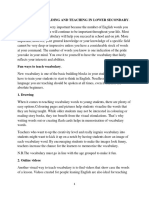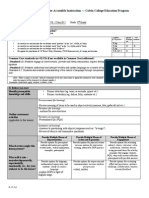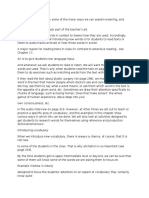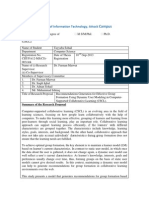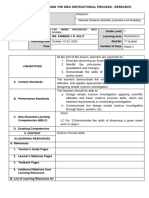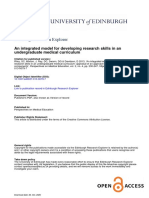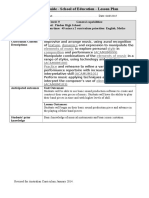Presenting and Practising Language
Presenting and Practising Language
Uploaded by
valerika1989Copyright:
Available Formats
Presenting and Practising Language
Presenting and Practising Language
Uploaded by
valerika1989Copyright
Available Formats
Share this document
Did you find this document useful?
Is this content inappropriate?
Copyright:
Available Formats
Presenting and Practising Language
Presenting and Practising Language
Uploaded by
valerika1989Copyright:
Available Formats
Presenting And Practising Language
students need to learn various aspects of language: grammar,vocabulary, pronunciation and functions. In order to learn this language, teachers need to present the new language to students and create situations where the language can be practised. Revision and further practice are also essential in subsequent lessons. The amount of revision carried out in later lessons will depend on the students leveland on their mastery of the language point. Here we will look at how to present grammar, vocabulary and functions, how to revise language and how to create situations to practise both new and known language. Pronunciation will be the topic of a separate chapter. From a language learners point of view, presentation of language is probably the most important aspect of studying English. Students expect lessons to contain some degree of language study, either long and intensive or short and sharp, depending on whichever is appropriate its most often what they note in their books and take away with them. The stages are: 1. find out how much students already know about the language point; 2. presentation; 3. check students have understood the presentation; 4. practice (controlled and/or free). In following lessons: 1. If it was the first time the students encountered the language item, you can do another brief presentation and then do some more activities to practise the language. 2. If students are familiar with the language item, you can go immediately to more practice activities. Stage 1: Pre-checking knowledge Before presenting any language, it is useful to find out how much your students know about the language point in question. You can get an idea of what they have studied by looking through their course book and previous work. However, the fact that the students have studied a particular language point does not mean they know it. In class,you can check to what extent they know the language by eliciting phrases that include the language point. This can be done relatively quickly; e.g. you can show pictures of people in action to your students and ask them what the characters are doing to check knowledge of present continuous and / or verbs of action (hes running, shes dancing,theyre playing tennis). You can also check the extent of their knowledge by asking them to carry out a speaking activity that requires use of the language point e.g. speaking about last years holidays to ascertain students knowledge of the simple past and other past tenses. This will take longer but you will have more of an idea of what students know. You can take an exercise from your course book or workbook for this pre-checking stage. Course books contain many exercises that are intended to be used as practice after the presentation stage. You can take one of these exercises and use it before presentation to find out students level. You can also design your own exercises. For example, if you want to find out whether beginner or elementary level students are familiar with wh question words (who, what, when, where, why) you could prepare a list of questions with wh words and the corresponding answers. Mix up the questions and answers and ask students to reorganise them. Below is an example: What did she do? At 3pm.
What time did she do it? Because she thinks Meryl Streep is a brilliant actress. Who did she do it with? She went to see The Devil Wears Prada. When did she do it? At the cinema. Where did she do it? Her best friend. Why did she do it? On Saturday. Comment: each question is similar to avoid giving away too many clues and to keep the focus on the wh word. You can prepare similar exercises where students match items to practise other language points: e.g. words and their definitions to check knowledge of vocabulary. You can also use matching exercises to teach first and second conditionals. The first conditional involves the use of simple present and will, e.g. if it rains tomorrow, Ill stay at home. The second conditional involves the use of simple past and would, e.g. if I won a million dollars, Id buy a big house. A further example is: if you are about to teach your students how to form questions through word order inversion; you can first of all check to what extent they can form questions already.A quick and simple way to check students knowledge of word order is to write out some simple sentences and then to jumble up the words. I suggest you use approximately ten sentences varying in difficulty. Give students the jumbled sentences and ask them to put words in the right order. Where did you buy your dress? Buy / dress / where / your / you / did / What time do you usually go to bed? Usually / time / go / you / what / do / bed / to What is your mothers name? Mothers / what / name / your / is Organising activities such as the above can be used to pre-check any language point that involves knowledge of word order. Of course, students can do exercises such as those above in pairs. This can help create an environment of cooperation, and works well when you want a general idea of how well the class copes with the language item. However, if you want to know the level of knowledge of individual students, pay very close attention while theyre working. The beauty of exercises such as those above is that they are easy to prepare and they can be used to check extent of knowledge or be used as revision in a subsequent lesson. And why not, occasionally, use the same activity to pre-check knowledge and to revise? This will allow you and your students to compare initial performance with performance post-presentation of language. It can be very motivating for students to see how well they have progressed. Stage 2: Presentation There are a variety of ways to present language; they vary in the amount of student and teacher involvement. I will outline and comment on some options below. Explanation You can give an explanation in English or in the students mother tongue. For example, you can explain that the simple past is used for an action at a specific time in the past and that the past perfect tense is used for an action that happened previous to that action. When I got home last night my husband had already cooked dinner. Got = simple past had cooked = past perfect (action happened before I got home) (Change to husband to wife if you think its more appropriate for your students!) Students used to a traditional way of teaching tend to like and expect this type of presentation. The downside is that students might not understand the explanation; very often the language used in the explanation is more complex than the structure itself. It also requires an understanding of syntax and the words used to describe language(verb, object, etc). You can get around this by giving examples (as I did above) or by using the students mother tongue briefly. If you choose explanation as a method of presenting, I suggest you make a note on your lesson
plan of what you intend to say in class as well as example sentences. Demonstration You can demonstrate the language you wish to teach. For example, if you get students attention and drop your pen on the floor, you can say, Ive just dropped my pen. You can also use demonstration to teach the present continuous for actions happening at the moment; e.g. Im writing on the board; Susan is listening to me. You can use mime to demonstrate action verbs: climbing, running, walking, etc. You can also use objects or the students themselves to teach comparatives and superlatives: John is taller than Susan. Stephen is the tallest person in the class. Demonstration works well for some language points but not all; its best for things happening around the present moment and action verbs. One disadvantage is that students may not understand the demonstration; it is advisable to follow up a demonstration with an explanation. Illustration This method is excellent for teaching vocabulary, especially at lower levels. You can show pictures of objects you want to teach; you can draw items on the board or cut pictures out of magazines. You can even use the real item (known as realia); it is very memorable for students to see spoons, forks, plates, bracelets, watches, buttons, etc in class. The use of pictures is also memorable, especially for visual learners. It is also easy and time efficient to go back to the language item: you just hold up the item and invite students to tell you what it is, no need for an explanation or complicated elicitation. You can also use this method to teach structures. For example, if you want to teach the present perfect continuous, e.g. Hes been doing his homework since 7pm. You can show, or draw, a picture of John at 7pm settling down to his homework. You can then show a picture of him at 9pm, still doing his homework. You can use the situation to teach or elicit hes been doing his homework since 7pm. One drawback of illustration is that it is time-consuming for the teacher to gather together items before the lesson and they can be heavy to carry in to class. Pictures can help you get around this; I suggest your start building up a picture bank as soon as possible. Discovery / deducing meanings This approach guides students to learn for themselves rather than the teacher teaching the language point directly. The discovery method involves students studying language items in a text or in isolated sentences. If isolated sentences are used, its preferable to provide a context. Students deduce grammatical rules, use of tenses, use of the infinitive contrasted with use of verb with ing. or meanings of words from what they read. (The possibilities are endless). Students then check with the teacher whether their deductions are correct. For example, you can give your students the following sentences and ask them to tell you the names of the tenses used (present perfect and simple past) and to tell you why they are used: (simple past to talk about a specific time in the past and present perfect to talk about experiences). Ive never been to Brazil: present perfect to talk about experiences. Shes never eaten snails: present perfect to talk about experiences. We went to Corsica on holiday last year: simple past to talk about a specific time in the past. I had beef for dinner last night: simple past to talk about a specific time in the past. To give a personal example, many years ago I studied elementary German. One day our teacher asked us to read a text relating what the writer had done the previous day and to answer questions on this text. The text contained elements such as the following: Yesterday I got up late, ate breakfast quickly and had a shower. I left the house at
8.30. We all knew the German for yesterday, get up, eat, have and leave; this meant that we were able to understand the text even though we had never studied the German equivalent of got, ate, had and left. Our teacher then proceeded to a study of language; she put 2 columns on the board with the headings every day and yesterday. In the every day column, she wrote: get up, eat breakfast, have a shower, leave the house. She asked us to provide the verb forms for the yesterday column and then asked us why the verb form was spelt differently: theyre in the past tense of course. She elicited from us the name of the tense and the verb forms even though we were new to this structure. This is a highly effective method of teaching; it involves students 100% in the lesson;the source of knowledge becomes the class rather than the teacher; the teacher has the chance to see who knows the language item and to what extent. This helps plan subsequent lessons; it might be that your students know the structure and just require brief revision and practice. Alternatively, they might need a complete presentation,explanation and extensive practice. It is also very memorable. I studied German almost 20 years ago and can still remember this lesson and the feeling of joy at understanding and discovering this language for myself. This approach works well for revising language that students should already know and it can be used for new language if the meaning is obvious (as in the example above). This approach engages students in the learning process and as such it is more memorable, especially if they get it right! Using this method in class will encourage students to do the same thing outside the classroom whenever they see the written word; this will be an excellent learning tool for them. Disadvantages are that students might be resistant to this method if theyre not used to it. If you use this method once and you explain the language point after the discovery phase, they will accept it more easily on subsequent occasions. Another drawback is that it requires a teacher to have thorough knowledge of the language point. Students sometimes come up with something theyve heard somewhere else and have misunderstood and you will need to confirm or correct, what they say. I suggest you experiment with this method on a language point you know well and not the first time you teach a complicated structure! Stage 3: Check students understanding When you have completed your presentation of language, you will need to check whether students have understood. It is not enough to ask students whether they understand or whether everything is clear. The result will simply be their assurances that they understand. It is far better to devise a method that checks they have understood. For example, after presenting question formation involving present simple you could write on the board: she likes animals and invite students to make the question. Students should be able to say does she like animals?. You can invite a student to the board to write the question or invite the class to produce it orally. You could accidentally add an s to like: does she likes animals? or make a similar error to see whether students notice and correct it. If so, make sure you remove the extra s so students dont copy it into their books. You can also use a technique called concept check questions (CCQs). You need to ask questions that will lead students to the precise meaning of the language item. First of all check the precise meaning of the language item and then create questions accordingly. For example, comparative adjectives are used to describe two things that differ and to compare the elements that differ. In the sentence: Sally is taller than Jane, you could ask the students: Are Sally and Jane are the same size? (No). Is Jane is taller than Sally? (No). Is Jane shorter than Sally? (Yes).
If students answer the questions correctly, you can assume that theyve understood the language point.
Stage 4: Practising language points After presenting language, set a practice activity that allows students to use the language they have just studied. This should be done as soon as possible after the presentation of the language point in order to consolidate learning. Controlled practice and freer practice (for definitions see Chapter 1) are useful at lower levels. At higher levels, you might be able to skip controlled practice and move directly to free practice. The following activity is an example of controlled practice of questions and short answers: e.g. did she leave work late? Yes, she did or no, she didnt. The example is in the simple past but you can change the tense. The objective of the activity is to answer questions without using the words yes or no. Start by demonstrating the activity to the class. Students ask you questions about what you did yesterday; you reply without hesitating and without using the words yes orno. For the first round, you could write some questions on the board as prompts, so students dont spend too long formulating their questions. Example: Did you go to work yesterday? Did you finish work at 6pm? Did you have lunch with friends? Students read out the questions and the person in the hot seat (this is the teacher during the presentation phase) responds with I did or I didnt. You continue with this for one minute. To help with timing, you can take in a stopwatch, an egg timer or ask a student to time you. If anybody uses the words yes or no, they are eliminated. If somebody speaks for one minute without using those words, he/she gets 10 points. You could then ask a student to come to the front of the class to provide further demonstration of the activity. When students are clear about what is expected of them, separate them into groups of at least three. One person is in the hot seat and the others ask questions; one person is responsible for keeping an eye on the time. You can find more games that provide controlled practice of language in the Communication Games series. Stage 5: Revision You will need to go back in later lessons and review the new language briefly. Try to vary presentations by using a different presentation method the second time. Use presentation methods in a logical order. For example, use explanation before discovery and not vice versa. Doing a brief second presentation will remind students and give them a chance to clear up any outstanding questions and will help any students who were absent in the previous lesson. You should also give further practice of the language item. Try to introduce variety into the exercises; if your course book contains a number of exercises, decide which are suitable for use in the first lesson and which you will save for revision on another day. A final word on presenting and practising language I suggest you go through your course book and see how language is presented and practised. You can decide whether the books approach is the best method for your students and for the language point. Also decide whether the practice exercises are sufficient. You can follow the procedure in the book, adapt it, supplement it or omit exercises as you think necessary.
You might also like
- Language Teacher Recognition: Narratives of Filipino English Teachers in JapanFrom EverandLanguage Teacher Recognition: Narratives of Filipino English Teachers in JapanNo ratings yet
- Manual of American English Pronunciation for Adult Foreign StudentsFrom EverandManual of American English Pronunciation for Adult Foreign StudentsNo ratings yet
- Complexity in Classroom Foreign Language Learning Motivation: A Practitioner Perspective from JapanFrom EverandComplexity in Classroom Foreign Language Learning Motivation: A Practitioner Perspective from JapanNo ratings yet
- A 10 minute intro to Business English Teacher Development SessionsFrom EverandA 10 minute intro to Business English Teacher Development SessionsNo ratings yet
- Second Language Writing Instruction in Global Contexts: English Language Teacher Preparation and DevelopmentFrom EverandSecond Language Writing Instruction in Global Contexts: English Language Teacher Preparation and DevelopmentNo ratings yet
- Intelligent and Effective Learning Based on the Model for Systematic Concept TeachingFrom EverandIntelligent and Effective Learning Based on the Model for Systematic Concept TeachingRating: 5 out of 5 stars5/5 (1)
- Master the Essentials of Micro Teaching: Pedagogy of English, #3From EverandMaster the Essentials of Micro Teaching: Pedagogy of English, #3No ratings yet
- Preston Lee's Conversation English For Japanese Speakers Lesson 21: 40From EverandPreston Lee's Conversation English For Japanese Speakers Lesson 21: 40No ratings yet
- How To Describe Learning and TeachingDocument5 pagesHow To Describe Learning and Teachingmoonis14100% (3)
- Teaching Language ConstructionDocument5 pagesTeaching Language ConstructionManyu RadjabliNo ratings yet
- Grammar LessonDocument9 pagesGrammar Lesson7pzm7xxc7zNo ratings yet
- Teaching TechiquesDocument56 pagesTeaching Techiquesmartin pontNo ratings yet
- Chapter 2 - The Study of EnglishDocument25 pagesChapter 2 - The Study of EnglishHien TruongNo ratings yet
- Listening Subskills 2Document4 pagesListening Subskills 2geethark12No ratings yet
- Clarifying New Language: Test-Teach-Test: Bjarne VonsildDocument7 pagesClarifying New Language: Test-Teach-Test: Bjarne VonsildRenanNo ratings yet
- Session #2 and #3 - Online TTCDocument6 pagesSession #2 and #3 - Online TTCelnazzarei1994No ratings yet
- 6 PPDH Tiếng Anh THCS (CN)Document10 pages6 PPDH Tiếng Anh THCS (CN)Huyền Ngáo NgơNo ratings yet
- Quiz Elt Methods: InstructionDocument4 pagesQuiz Elt Methods: InstructionFayza Nashrillah KimNo ratings yet
- Voc TeachDocument26 pagesVoc TeachVíctorNo ratings yet
- Teaching Language ConstructionDocument6 pagesTeaching Language ConstructionMerita Devi Agni100% (1)
- TPR ModuleDocument9 pagesTPR ModulePeggy HungNo ratings yet
- Three Strategies For Teaching Grammar in ESL: July 5, 2012 IxchellDocument24 pagesThree Strategies For Teaching Grammar in ESL: July 5, 2012 IxchellJett RoyNo ratings yet
- Module 2.1 - GrammarDocument7 pagesModule 2.1 - GrammarThuonggipNo ratings yet
- 1 Clarifying New Language Situational Language ClarificationDocument6 pages1 Clarifying New Language Situational Language ClarificationRenanNo ratings yet
- From Priming Tasks and Target Tasks To Language Focus and GrammarDocument6 pagesFrom Priming Tasks and Target Tasks To Language Focus and GrammarAlejandro Figueroa AvilaNo ratings yet
- Lesson Rationale Observación ReflexionesDocument40 pagesLesson Rationale Observación ReflexionesJulieta Vega DelgadoNo ratings yet
- STEPP Lesson Plan Form: Content Standard(s) Addressed by This LessonDocument6 pagesSTEPP Lesson Plan Form: Content Standard(s) Addressed by This Lessonapi-264548225No ratings yet
- PORTFOLIO Met 5Document37 pagesPORTFOLIO Met 5jeanet ramosNo ratings yet
- Module 4 - How To Teach GrammarDocument13 pagesModule 4 - How To Teach GrammarAzizan ShafieNo ratings yet
- How To Teach GrammarDocument3 pagesHow To Teach GrammarmummyhartiniNo ratings yet
- How To Teach GrammarDocument3 pagesHow To Teach GrammarmummyhartiniNo ratings yet
- Activity Type: Several Short Speaking Activities Level: A2+ Age: Teenage/AdultDocument6 pagesActivity Type: Several Short Speaking Activities Level: A2+ Age: Teenage/AdultAgung Adyatmika100% (1)
- Vocabulary InstructionDocument4 pagesVocabulary InstructionIbnu Shollah NugrahaNo ratings yet
- Headway5thEd Pre Intermediate TeachersGuideDocument150 pagesHeadway5thEd Pre Intermediate TeachersGuideAmbra Ferrarotto100% (9)
- HW5e PreIntermediate TG Unit01 PDFDocument13 pagesHW5e PreIntermediate TG Unit01 PDFMatheus PereiraNo ratings yet
- GrammarDocument34 pagesGrammarRatnaKhartikaNo ratings yet
- Reviewing Time With The SongDocument6 pagesReviewing Time With The SongSimona Brezan AioaniNo ratings yet
- Vocabulary Building and Teaching in Lower SecondaryDocument17 pagesVocabulary Building and Teaching in Lower SecondaryPendi KurniawanNo ratings yet
- Vii-Teaching Grammar: How To Teach Grammar: A Guide For TEFL TeachersDocument32 pagesVii-Teaching Grammar: How To Teach Grammar: A Guide For TEFL TeachersGiovanni AlcainNo ratings yet
- Millicent Atkins School of Education: Common Lesson Plan TemplateDocument12 pagesMillicent Atkins School of Education: Common Lesson Plan Templateapi-346302593No ratings yet
- Prepositions in The English Language Form An Extremely Important Word Class Because of Their Frequent UseDocument6 pagesPrepositions in The English Language Form An Extremely Important Word Class Because of Their Frequent UseNadica1954No ratings yet
- How To Teach Prepositions of PlaceDocument4 pagesHow To Teach Prepositions of Placeapi-252821028100% (1)
- Lesson 3 UnitplanDocument4 pagesLesson 3 Unitplanapi-270544572No ratings yet
- How To Teach GrammarDocument40 pagesHow To Teach GrammarQuang Hien Vo100% (1)
- Planning A Grammar LessonDocument10 pagesPlanning A Grammar LessonDado DodoNo ratings yet
- Reflective Lesson PlanDocument4 pagesReflective Lesson PlanStefon Bowman100% (2)
- In Chapter 12Document31 pagesIn Chapter 12dianaNo ratings yet
- Edss 511 - 1st Lesson Unit PlanDocument4 pagesEdss 511 - 1st Lesson Unit Planapi-246041784No ratings yet
- Receptive Practice ActivitiesDocument3 pagesReceptive Practice ActivitiesDRISS BAOUCHENo ratings yet
- Foundation - Online - Unit - 7Document10 pagesFoundation - Online - Unit - 7Franz goNo ratings yet
- Assignment 7Document3 pagesAssignment 7TOONZNo ratings yet
- Individual Activity (AI) IIDocument2 pagesIndividual Activity (AI) IISvetlana KazánovaNo ratings yet
- MA TeachingGrammar1Document13 pagesMA TeachingGrammar1Esls TrainerNo ratings yet
- Lesson ShapesDocument7 pagesLesson ShapesFrancesca MortaraNo ratings yet
- Presenting VocabularyDocument9 pagesPresenting VocabularyEnglish Kids SchoolNo ratings yet
- Millicent Atkins School of Education: Common Lesson Plan TemplateDocument4 pagesMillicent Atkins School of Education: Common Lesson Plan Templateapi-548831833No ratings yet
- Chinese For Working Professionals A Textbook For Intermediate-High To Advanced Learners by Yi Zhou, Haidan WangDocument169 pagesChinese For Working Professionals A Textbook For Intermediate-High To Advanced Learners by Yi Zhou, Haidan Wangnat lamNo ratings yet
- Effects of Instruction in Morphological Awareness On Literacy AchievementDocument8 pagesEffects of Instruction in Morphological Awareness On Literacy AchievementAndi SudihartoNo ratings yet
- English Lesson Plan Form 5 SSTP ModuleDocument2 pagesEnglish Lesson Plan Form 5 SSTP ModuleganaNo ratings yet
- Jurnal Wacana Kinerja Volume 19 Edisi 1 Juni 2016Document32 pagesJurnal Wacana Kinerja Volume 19 Edisi 1 Juni 2016Ahmad YunusNo ratings yet
- Antonio Bratto The Teaching BrainDocument6 pagesAntonio Bratto The Teaching BrainMaría Alejandra GarciaNo ratings yet
- Distributor ManagementDocument12 pagesDistributor ManagementtaolaNo ratings yet
- Homeroom Guidance FormDocument87 pagesHomeroom Guidance FormBadeth AblaoNo ratings yet
- EmilypilipczukresumeDocument3 pagesEmilypilipczukresumeapi-356876213No ratings yet
- Rachna Iyer - Orgnization DescriptionDocument3 pagesRachna Iyer - Orgnization DescriptionRachna IyerNo ratings yet
- Lesson Plan 3Document2 pagesLesson Plan 3api-454888263No ratings yet
- FS 1 - ReflectionDocument2 pagesFS 1 - ReflectionHannah Nicole ColomaNo ratings yet
- Edtpa Urlp SehDocument44 pagesEdtpa Urlp SehChristina PietschNo ratings yet
- Sains - Tahun 2Document35 pagesSains - Tahun 2Sekolah Portal100% (12)
- Ashley Andree Resume 2016Document3 pagesAshley Andree Resume 2016api-255264505No ratings yet
- Models of TeachingDocument60 pagesModels of TeachingHidayah Roslee100% (2)
- International Journal of Instruction July: e-ISSN: 1308-1470Document4 pagesInternational Journal of Instruction July: e-ISSN: 1308-1470AyuNo ratings yet
- SIG Vortrag Fliesser V2 1finalDocument16 pagesSIG Vortrag Fliesser V2 1finalLena CoradinhoNo ratings yet
- School Readiness Year-End Assessment: ItemsDocument16 pagesSchool Readiness Year-End Assessment: ItemsJennifer SayongNo ratings yet
- Gpev2623 U4.Document14 pagesGpev2623 U4.AbigailNo ratings yet
- Thesis Synopsis ProformaDocument8 pagesThesis Synopsis Proformatayyaba_sNo ratings yet
- Lesson Plan English Year 4 - World of KnowledgeDocument3 pagesLesson Plan English Year 4 - World of Knowledgepdah_nazri100% (3)
- CONSMATDocument22 pagesCONSMATMa Ella Mae LogronioNo ratings yet
- Grade 7 - Research-LC 3Document2 pagesGrade 7 - Research-LC 3kimberly.sulit100% (1)
- Bilingual EducationDocument31 pagesBilingual EducationSheila Garcia NorthNo ratings yet
- 2009 Pepperdine University Information Technology Annual ReportDocument15 pages2009 Pepperdine University Information Technology Annual ReportPepperdine University Information TechnologyNo ratings yet
- Edinburgh Research Explorer: An Integrated Model For Developing Research Skills in An Undergraduate Medical CurriculumDocument19 pagesEdinburgh Research Explorer: An Integrated Model For Developing Research Skills in An Undergraduate Medical Curriculumsujaysarkar85No ratings yet
- Drama 8 Week 4 Lesson PlanDocument3 pagesDrama 8 Week 4 Lesson Planapi-533472774No ratings yet
- Art1 3Document8 pagesArt1 3Donna Joyce MagdaongNo ratings yet
- The Influence of Television Shows and Movies On Learning English in English Language ClassroomsDocument10 pagesThe Influence of Television Shows and Movies On Learning English in English Language ClassroomsLiloNo ratings yet
- Year 9 Music Lesson 1Document3 pagesYear 9 Music Lesson 1api-357434713No ratings yet









































